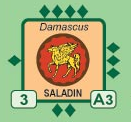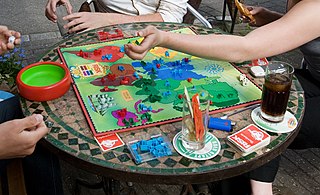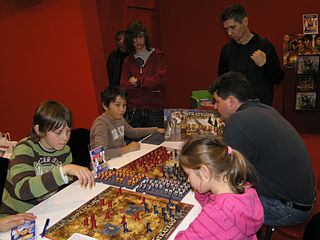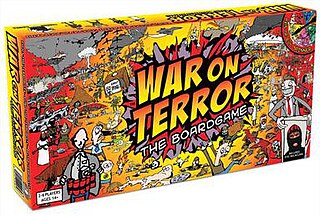 W
WA board wargame is a wargame with a set playing surface or board, as opposed to being played on a computer or in a more free-form playing area as in miniatures games. The modern, commercial wargaming hobby developed in 1954 following the publication and commercial success of Tactics. The board wargaming hobby continues to enjoy a sizeable following, with a number of game publishers and gaming conventions dedicated to the hobby both in the English-speaking world and further afield.
 W
WThis is a list of board wargames by historical genre showing their publication history. All games can be presumed to have been published in English unless another language is noted.
 W
WA monster game is a game that is either very large, or very complex or both. Another criterion adopted is the number of pieces, for example above 1000 counters. This classification can be applied to any board game, but commonly refers to wargames with much playing time. There is controversy over which would have been the first monster game in the field of wargames with many stating that Drang Nach Osten! was pretty universally accepted as the first monster wargame. Drag Nach Osten and his companion, Unentschieden led to the Europa Series games, a giant WWII game.
 W
WAge of Mythology: The Boardgame is a board game created by Glenn Drover based on the video game Age of Mythology. It was released in 2003 by Eagle Games. Up to four players may play the game, but extra parts may be purchased from Eagle Games to allow eight players to play.
 W
WAlexander the Great is a board wargame first published in 1971 by Guidon Games.
 W
WAnachronism is a tabletop game with aspects of both miniatures and collectible card genres. The basis of the game is war between various historical characters. The creators of the game, TriKing Games and The History Channel, have dubbed it "The Greatest Game in History". Anachronism won the 2005 Origins Award for Gamer’s Choice Best Collectible Card Game of the Year.
 W
WA block wargame is a board wargame that represents military units using wooden blocks instead of cardboard counters or metal/plastic miniatures. These blocks are typically square, have a labeled and an unlabeled side, and are generally thick enough that they can be placed on their side with the labeled side facing the owning player. Details about the unit can then be seen easily by the owning player, while the opposing player will be left unsure of the exact nature of piece; while he can see where his rival's forces are, fog of war is emulated by preserving the secrecy of the type and quality of the troops.
 W
WBritannia is a strategy board game, first released and published in 1986 by Gibsons Games in the United Kingdom, and The Avalon Hill Game Company in 1987 in the United States, and most recently updated in late 2008 as a re-release of the 2005 edition, produced by Fantasy Flight Games. It broadly depicts the wars in, and migrations to, the island of Great Britain in the centuries from the Roman invasions to the Norman Conquest.
 W
WChandragupta is a board wargame designed by Stephen R. Welch and released in 2008 by GMT Games as part of the Great Battles of History (GBoH) series of games on ancient warfare. Chandragupta simulates battles fought by the Mauryan Dynasty in ancient India, and in so doing, attempts to illuminate the features, challenges, and unique attributes of the Indian military system and culture during this period.
 W
WChowka Bara or Ashta Chamma is a two- or four-player board game from India. This game is an example of a “fully observable” system that has an element of chance introduced by the roll of special dice and an element of strategy. While traditionally played with 4 or 6 cowry shells, dice can also be used.
 W
WSky Galleons of Mars is a board wargame designed by Frank Chadwick, Marc W. Miller and Loren Wiseman, published in 1988 by Game Designers' Workshop. It is set in an alternate Victorian Era where the major nations of Earth are extending their colonial interests on Mars and Venus. The discovery of Liftwood, a Martian plant endowed with anti-gravity powers, allows the deployment of aerial fleets in the skies of the Red Planet.
 W
WCommands & Colors: Ancients is a board wargame designed by Richard Borg, Pat Kurivial, and Roy Grider, and published by GMT Games in 2006. It is based on Borg's Commands & Colors system using some elements similar to his other games such as Commands & Colours: Napoleonics, The Great War, Memoir '44 and Battle Cry designed to simulate the "fog of war" and uncertainty encountered on real battlefields.
 W
WConquest is a strategy board game created and published by Donald Benge. First published in 1972 with cardboard pieces, it evolved to plastic pieces and a deluxe set in pewter plated in various metals including gold.
 W
WConquest of the Empire is a military strategy board game set in the Roman Empire after the death of Marcus Aurelius, with 2 to 6 players pitting their armies against each other in an attempt to become the ruler of Rome. The game was originally created in 1982 by Larry Harris and published by The Citadel under the title VI Caesars. Harris revised the game for Milton Bradley in 1984 to be reissued under the title Conquest of the Empire as part of the Gamemaster series. The game was re-released in the summer of 2005 by Eagle Games, redesigned by Glenn Drover. The gameplay in Conquest of the Empire shares similarities to Axis & Allies, another Larry Harris project within the same series.
 W
WConquistador, originally subtitled "The Age of Exploration: 1495–1600", is a board game published by Simulations Publications, Inc. (SPI) in 1976 that simulates the exploration of the New World in the 16th century. Players take on the role of European countries sending expeditions to find gold and establish colonies. Although the design uses the trappings of board wargames such as a hex map, combat is not a major part of the game.
 W
WA counter is usually a small cardboard square moved around on the map of a board wargame to represent relevant information or determine certain things. The first wargame based on cardboard counters was War Tactics or Can Great Britain Be Invaded? invented by Arthur Renals of Leicester in 1911. The first wargame bringing counters to a mass-market was Tactics, invented by Charles S. Roberts in 1952. Traditional wargames typically have hundreds of counters. Squad Leader had counters of different sizes: 520 1⁄2-inch counters and 192 5⁄8-inch, with the different sizes used for different purposes.
 W
WFeudal is a chess-like board wargame for 2–6 players on two or four opposing sides. It was originally published by 3M Company in 1967 as part of its bookshelf game series, and was republished by Avalon Hill after they purchased 3M's game division. The object of the game is to either occupy one's opponent's castle or to capture all of one's opponent's royalty. There are six sets of plastic pieces in three shades each of blue and brown. Each set consists of thirteen mobile figures with differing methods of movement and attack, and a stationary castle piece. The play area consists of four plastic peg boards depicting empty, rough, and mountainous terrain.
 W
WFriedrich is a strategy board game about the events of the Seven Years' War. It was created by Richard Sivél, published in 2004, and won the prize for the Best Historical Simulation by Games magazine in 2006.
 W
WThe Game of the Generals, also called GG or GOG as it is most fondly called, or simply The Generals, is an educational war game invented in the Philippines by Sofronio H. Pasola Jr. in 1970. Its Filipino name is "Salpakan." It can be played within twenty to thirty minutes. It is designed for two players, each controlling an army, and a neutral arbiter to decide the results of "challenges" between opposing playing pieces, that like playing cards, have their identities hidden from the opponent.
 W
WThe Gamemaster Series of board games consists of five war simulation games released by the game company Milton Bradley beginning in 1984. The games were not developed "in-house" by Milton Bradley, with each game initially published in limited runs by smaller game publishers in the early 1980s before their rights were acquired by Milton Bradley. Despite this, some modern reissues of these games refer to the Milton Bradley versions as the "first edition" of each game.
 W
WKing Arthur, subtitled "The Battle of Stonehenge, 536", is a board wargame published by Simulations Publications, Inc. (SPI) in 1979 that simulates the fictional Battle of Camlann between the forces of King Arthur and his son Mordred.
 W
WRanger: Simulation of Modern Patrolling Operations is a tactical solitaire board wargame released by Omega Games in 1984. It was billed as a "game of modern patrolling". The game was designed by Bill Gibbs, and focussed on contemporary small unit actions, placing the player in the position of a patrol leader.
 W
WRisiKo! is a strategy board game, Italian stand alone variant of Risk. The purpose of the game is the achievement of a predefined, secret target that is different for each player: the target can consist either in the conquest of a certain number of territories, of two or more continents, or in the annihilation of one opponent.
 W
WRisk is a strategy board game of diplomacy, conflict and conquest for two to six players. The standard version is played on a board depicting a political map of the world, divided into forty-two territories, which are grouped into six continents. Turns rotate among players who control armies of playing pieces with which they attempt to capture territories from other players, with results determined by dice rolls. Players may form and dissolve alliances during the course of the game. The goal of the game is to occupy every territory on the board and, in doing so, eliminate the other players. The game can be lengthy, requiring several hours to multiple days to finish. European versions are structured so that each player has a limited "secret mission" objective that shortens the game.
 W
WShogun is a strategy board game designed by Dirk Henn and published by Queen Games in 2006. It is based on his earlier game Wallenstein, but it is set in the Sengoku period, which ends with the inception of the Tokugawa Shogunate.
 W
WStratego is a strategy board game for two players on a board of 10×10 squares. Each player controls 40 pieces representing individual officer and soldier ranks in an army. The pieces have Napoleonic insignia. The objective of the game is to find and capture the opponent's Flag, or to capture so many enemy pieces that the opponent cannot make any further moves. Stratego has simple enough rules for young children to play but a depth of strategy that is also appealing to adults. The game is a slightly modified copy of an early 20th century French game named L'Attaque. It has been in production in Europe since World War II and the United States since 1961. There are now two- and four-handed versions, versions with 10, 30 or 40 pieces per player, and boards with smaller sizes. There are also variant pieces and different rulesets.
 W
WSupremacy: The Game of the Superpowers is a political, economical, and military strategic board wargame published in 1984 by Supremacy Games, and designed by Robert J. Simpson.
 W
WTactical wargames are a type of wargame that models military conflict at a tactical level, i.e. units range from individual vehicles and squads to platoons or companies. These units are rated based on types and ranges of individual weaponry. The first tactical wargames were played as miniatures, extended to board games, and they are now also enjoyed as video games.
 W
WTactics is a board wargame published in 1954. Primitive by modern standards, it was nonetheless the birth of modern wargaming for the commercial market, and generally credited as being the first commercially successful printed wargame.
 W
WTeam Yankee is a techno-thriller novel written in 1987 by Harold Coyle, then a major in the United States Army, whose subject is the actions of a company-sized armor unit of the United States Army in the World War III scenario as depicted by General Sir John Hackett in his novel, The Third World War: The Untold Story. General Hackett's scenario takes place in 1985; Coyle never specifies the year, but it is assumed to take place in the late 1980s. While Hackett's book emphasizes strategy and world politics, Coyle's features the experiences of the tank crews and infantrymen fighting on the front lines.
 W
WPlan Táctico y Estratégico de la Guerra is an Argentinian strategy board wargame published in 1976, based on the game Risk. The name is Spanish for Tactical and Strategical War Plan.
 W
WWallenstein is a medium-weight German-style board game designed by Dirk Henn and published by Queen Games in 2002. Though set during the Thirty Years' War, Wallenstein should not be confused with a complex wargame. Rather, it has the feel of a light strategy game with the familiar Euro elements of area control and resource management mixed in. As such, it has a wide range of appeal that attracts wargamers and non-wargamers alike.
 W
WWar on Terror, The Boardgame is a satirical, strategic board game, produced and published in 2006 by TerrorBull Games. War on Terror was originally conceived in 2003 by Andy Tompkins and Andrew Sheerin, two friends based in Cambridge, England. The initial inspiration for the game came from the imminent Invasion of Iraq but, as a whole, was intended as a reaction and challenge to the counter-productive pursuit of the wider War on Terror. In 2005, Sheerin and Tompkins founded TerrorBull Games and gathered enough financial support from a mixture of friends and acquaintances to put War on Terror into production.
 W
WWarrior Knights is a board game for 2–6 players originally published by Games Workshop in 1985, and later published by Fantasy Flight Games in 2006. Each player takes the role of a Baron vying to claim the throne of an unnamed kingdom. Gameplay revolves around raising an army, obtaining enough money to maintain that army, and gaining influence through a variety of means.
 W
WIn board wargames, a zone of control (ZOC) is the area directly adjacent to certain combat forces that affects the movement and actions of enemy combat units. In hexagonal tiled maps, a combat unit's zone of control is the six hexagons adjacent to the hexagon occupied by a unit.